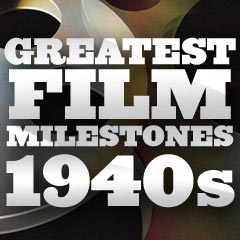
|
Milestones and Turning Points in Film History The Year 1944 |
![]()
(by decade and year) Introduction | Pre-1900s | 1900s | 1910s | 1920s | 1930s | 1940s | 1950s 1960s | 1970s | 1980s | 1990s | 2000s | 2010s | 2020s |
| Event and Significance | |
| The first Golden Globe awards ceremony took place at 20th Century Fox Studios, at first marked by the awarding of scrolls (not statuettes) to honorees (not nominees) who were announced earlier. | |
| The US government eased restraints on the depiction of brutality by the Japanese. | |
| A Los Angeles court ruled, in the so-called "Havilland decision," that Warner Bros. had to release actress Olivia de Havilland after her seven-year contract expired. It said that the studio could not add time to her contract to make up for the periods when she was on suspension. This ruling undercut studios' ability to lock actors into long-term contracts. | |
| The federal government reopened its anti-trust cases against the studios, and called for the divestiture of the studios' theaters. | |
| Billy Wilder's cynically-dark masterpiece, Double Indemnity (1944), a hard-boiled tale adapted from another James M. Cain novel (with Raymond Chandler as the co-scenarist), represented the peak of 'film noir'. Both lead actors, Barbara Stanwyck and Fred MacMurray (both playing against type) gave the performances of their careers, with MacMurray providing an effective first-person narration. Although the film had a steamy crime plot (an adulterous evil woman plots the murder of her husband through her association with an insurance investigator), it was able to follow the prescriptions of the Hays Code while still infusing the story with controversial sex and murder scenes. | |
| Producer/director Otto Preminger's mystery drama Laura (1944), was one of the most stylish, elegant, moody, and witty classic film noirs ever made, featuring an ensemble cast of characters, including the alluring and beautiful Gene Tierney. Trailers for the compelling film promised: "Never has a woman been so beautiful, so exotic, so dangerous to know!" | |
| A few years after his first lead film role in 1938, western star Roy Rogers' future wife Dale Evans was first cast in a movie opposite him (as Ysobel Martinez) in 1944 - Cowboy and the Señorita (1944). Following the 1946 death of Roy's wife Arline due to complications during childbirth, Roy married Dale on New Years Eve 1947. | |
| MGM's Dancing Romeo (1944) was the last Our Gang comedy short released - the 220th in the long-running 22 year-old series of shorts. MGM had acquired the series in 1938 after purchasing contracts and rights from Hal Roach (1922-1937). Our Gang was revived in popularity in the 1950s with the syndication of 80 Roach-produced shorts (with sound) to TV as The Little Rascals, since MGM retained the rights to the Our Gang trademark. | |
| The first Hollywood film advertised on TV in a 30-minute promotion in 1944 was the classic Preston Sturges screwball comedy The Miracle of Morgan's Creek (1944), although the film had already been released two months earlier. The TV ad was broadcast by Paramount in the second TV station (KTLA) that the studio had launched/established in Los Angeles in 1943. The preview program was hosted by Sturges himself, and included stills from the film, narration by star Eddie Bracken, and a brief interview with actress Diana Lynn. | |
| Barry Fitzgerald was the first - and only - actor to receive two Academy Award nominations, Best Actor and Best Supporting Actor, for the same role in the same year - as St. Dominic's stubborn, yet loveable old priest Father Fitzgibbon in Going My Way (1944). The Academy changed the rules so that it couldn't happen again. | |
| Swimmer Esther Williams starred in her first Technicolor aqua-musical in the MGM production of Bathing Beauty (1944). It featured synchronized swimming and diving numbers. | |
| MGM's Technicolored National Velvet (1944) premiered in New York City on December 14, 1944, bringing stardom and the first film success to 12 year-old child-star Elizabeth Taylor, who portrayed Velvet Brown. | |
| To Have and Have Not (1944) paired an unhappily-married Humphrey Bogart and young Lauren Bacall for the first time (this was Lauren Bacall's startling movie debut at 19 years of age). She was sensational when she first appeared with the sultry question: "Anybody got a match?", and then when she propositioned: "You know how to whistle, don't you, Steve? You just put your lips together - and blow." It led to one of Hollywood's most enduring romances. The couple actually fell in love together while making the film - and were married shortly afterwards in 1945. | |
| Disney's feature The Three Caballeros (1944), for the first time since the Alice comedies of the 1920s (and also Mickey Mouse's brief appearance in Fantasia (1940)), extensively combined live-action and animation. Along with Saludos Amigos (1942), these films were created in order to improve US relations with South American countries during World War II. |